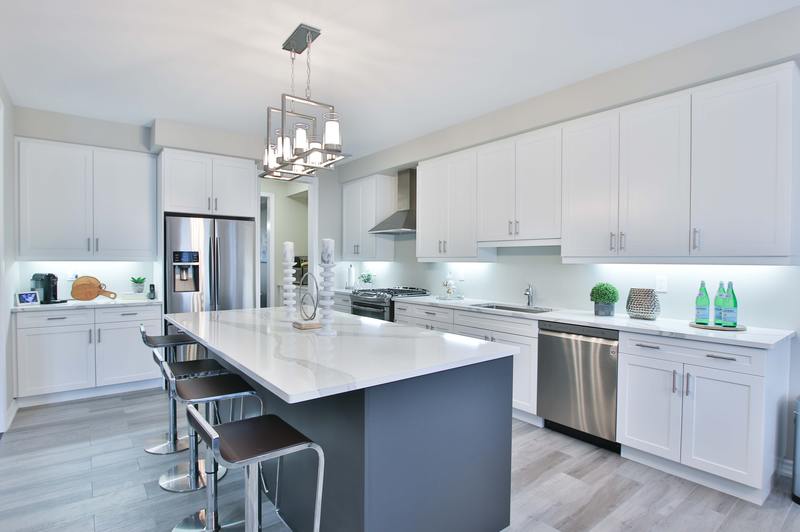In this article, the different ways on how to protect cabinet doors in water damaged kitchen will be discussed. The key actions to be taken are waterproofing and fixing leaks. Read on to get more details on how to execute these solutions.

Ways To Protect Kitchen Cabinet Doors
1. Waterproofing
There is no better way to avoid damage due to water than waterproofing things. Since spilling water is inevitable in the kitchen, the best course of action to protect your precious kitchen cabinets is to make them resistant to moisture. Let us see which parts of your kitchen need waterproofing to achieve that.
Kitchen sink
By kitchen sink, it means the area around it. Check the ceiling around it. Find and repair any cracks and loose caulks as these are areas where water may flow before damaging your cabinets.
How about the tiles around your sink? Is there any chipping or cracking grout? Be quick and replace, then refill those.
If your workstation is composed of wood materials, apply varnish to protect it. The damage that water may cause on those wooden surfaces can lead to cracks and leaks. These cracks and leaks will eventually find their way to your kitchen cabinets.
Lastly, waterproof the area underneath your sink. Bad installations will cause leaks that can damage your cabinets.
Pipes and faucets
The pipes and faucets are the lifelines of your kitchen. These are also the areas where leaks may occur and cause the most damage to your cabinets, such as in the case of burst pipes. Waterproofing your pipes and faucets will ensure that this will not happen.
You can already waterproof your PVC and metal pipes in under fifteen minutes using silicon for under ten dollars. This is way cheaper and less labor-intensive than having repairs in case of a water damaged kitchen.
Backsplash
Despite the trend in gorgeous backsplashes, take note that functionality and durability are more important. Waterproofing your backsplash with caulk will ensure that liquids from pans and pots will not go to the cabinets. Condensation from steam will also be prevented from going down the cabinets.
Cabinets
Finally, why not waterproof the cabinets themselves? Like with the wooden surfaces in your workstation, apply a good primer, then finish off with a clear varnish or polyurethane. With this, water will just run over the surface in case there are any splashes or leaks.
There are also spray-on rubber coatings that contain waterproof varnish. These are cheap and very easy to apply. Find one which is heat-resistant, durable, and dries quickly.
Alternatively, you may opt to install waterproof mats or stick vinyl tiles to the inside surface of your kitchen cabinet doors. Both these materials will repel water and protect your cabinet doors.
2. Fix the leaks
Another technique that goes hand in hand with waterproofing is leak detection and correction. Since moisture is the primary enemy of wooden cabinets, ensuring that water remains where they need to be contained is essential. In cases where preventive measures were not enough, and there is already leakage, it is equally important to know how to fix them.
Use a leak sensor
Prevention is better than cure. This famous phrase also applies to kitchen leaks. Bigger, more problematic cases are avoidable when these are spotted at an earlier time.
Leak sensors usually come in packs and sell between twenty to thirty dollars. The units are placed in the cabinet at the kitchen base. An alarm will go off once a leak is detected in the cabinet.
Watch out for molds
A definitive sign of moisture accumulation is when there is a mildew odor detected. The musty smell is caused by molds, which are organisms that require moisture to proliferate. The foul smell is noticeable even before you see the mold colonies, the looks of which vary from cottony patches to black spots.
If it ever happens that there is already mold growth in your cabinet, rub a rag soaked in alcohol in the affected areas. Prevent contaminating unaffected surfaces. Afterward, address the leak source, so this will not happen again.
Locate the leaks and patch them up
Leaks in the kitchen may be caused by wear and tear, malfunctioning components, or a problematic water valve. If you detected a leak or broken pipe, address it immediately. Do not hesitate to hire a professional service provider since a poor plumbing system can affect even the foundations of your house.
Additional tip: stay away from PVC boards
PVC (polyvinyl chloride) boards are gaining traction lately due to their attractive prices and ease of use. The cost of PVC boards can be cheaper by as much as half of hardwood and plywood prices.
PVC boards must be avoided as a base material for kitchen cabinets for the following reasons:
- PVC is not heat-resistant
- It cannot hold much weight, unlike metal or hardwood
- The frame bends over time and becomes deformed
- It is comparatively not durable and sags after ten to fifteen years
Conclusion
Now that you already know how to protect cabinet doors in water damaged kitchen, all you need to do is have the proper behavior in maintaining your kitchen cabinets. Remember to be constantly proactive and react quickly when a source of the leak is detected. You will commend yourself later for taking the necessary steps ahead and not waiting for your repair bill to skyrocket.
